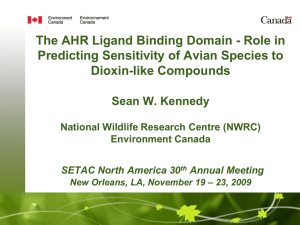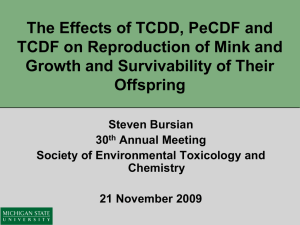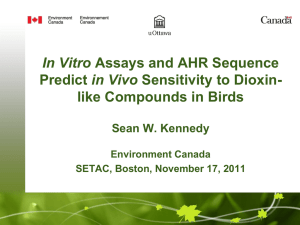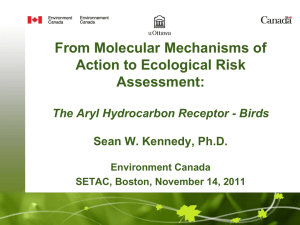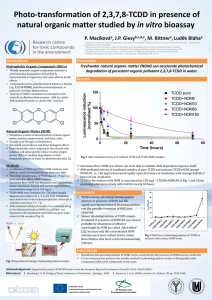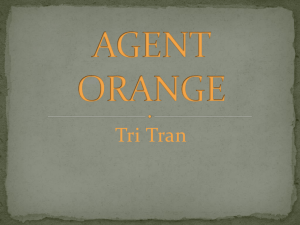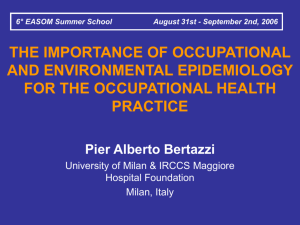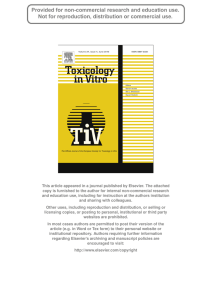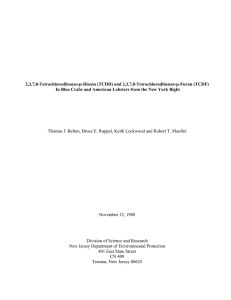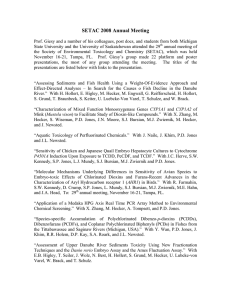Yinfei Yang
advertisement
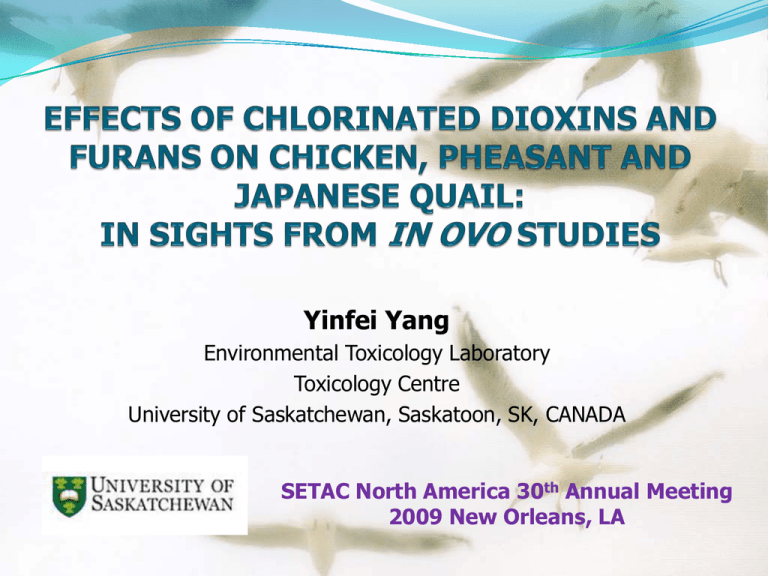
Yinfei Yang Environmental Toxicology Laboratory Toxicology Centre University of Saskatchewan, Saskatoon, SK, CANADA SETAC North America 30th Annual Meeting 2009 New Orleans, LA Dr. Dr. Dr. Dr. John P. Giesy Paul Jones Steve Wiseman Yi Wan Dr. John Newsted Dr. Denise Kay Dr. Sean Kennedy Jessica Hervé Reza Farmahin Dr. Steve Bursian Dr. Matt Zwiernik Andrew Cohen-Barnhouse Dr. Tim Fredricks Patrick Bradley Tittabawassee River Risk Assessment 2003: Michigan Department of Environmental Quality concluded that PCDDs and PCDFs exist at levels such that they may present a risk to wildlife. 110,000 PARTS PER TRILLION TEQ!!! A study throughout the Tittabawassee river floodplain was initiated to investigate the impact of dioxin and furan exposure from the environment. Tittabawassee River Risk Assessment ctd… 2,3,7,8-tetrachlorodibenzo-p-dioxin 2,3,7,8-tetrachlorodibenzofuran (TCDF) (TCDD) 2,3,4,7,8-pentachlorodibenzofuran (PeCDF) Routes of Exposure Aquatic Terrestrial Tropic Level Residency Migratory Resident Avian Health Assessment Individual Condition Measurement General Health Nestling Weight Nestling Growth Clutch Size (egg/nest) Reference vs. Tittabawassee No difference No difference No difference No difference Productivity (nestlings fledged/nest) No difference Population Condition Measurement Abundance Productivity Nestling Return Rates Adult Return Rates Reference vs. Tittabawassee No difference No difference No difference No difference The Aryl Hydrocarbon Receptor (AhR) Ligand Binding Domain (LBD) AATI K S AATVK A TAI I K A AhR Signaling Pathway Type 1: Chicken-like, Very Sensitive Type 2: Pheasant-like, Moderately Sensitive Type 3: Japanese Quaillike, Insensitive Kennedy et al. (Abstract 247) Study Design What are the effects of TCDD and PCDFs on differentially sensitive avian species? Impact of In Ovo Exposure to TCDD, PeCDF and TCDF Biomarker reponses in cultured hepatocytes Biomarker Responses Tittabawassee River Risk Assessment Mortality Data Egg Injection oHatch Success oMortality oDeformities Injection of 0.1 µl/g egg into the air cell of eggs with: oTriolein * Doses of each chemical, oTCDD selected to bound the predicted oPeCDF White-leghorn Chicken LD50 of that species! oTCDF (Gallus gallus domesticus) 14-d post hatch Inject egg Incubate Common Pheasant (Phasianus colchicus) Japanese quail (Coturnix japonica) oCYP1A mRNA •CYP1A4 •CYP1A5 oEROD activity Experimental Goal The objectives of these studies were to investigate the CYP1A response to DLCs, specifically TCDD, PeCDF and TCDF, in differentially sensitive avian species within the Order Galliformes. The null hypotheses for this study are: Within each species, there is no difference among the potencies of TCDD, TCDF and PeCDF. Within each chemical, there is no difference among the sensitivities of White-leghorn chicken, Common pheasant and Japanese quail. White-leghorn Chicken TCDD PeCDF * * * * * * * * * * * * * * * * * * * * * TCDF * * * * * * Kruskal-Wallis one-way ANOVA. Significant changes from control are denoted by * (P ≤ 0.1, Mann Whitney U Test) Common Pheasant TCDD PeCDF * * * * * * * * TCDF * * * Kruskal-Wallis one-way ANOVA. Significant changes from control are denoted by * (P ≤ 0.1, Mann Whitney U Test) Japanese Quail TCDD PeCDF * * * * * * ** * * * * * * A TCDF * * Kruskal-Wallis one-way ANOVA. Significant changes from control are denoted by * (P ≤ 0.1, Mann Whitney U Test) * Fold Change in CYP1A4 mRNA Abundance (Change from Control) LOEC Determination 25 20 Estimated LOEC value of Japanese quail CYP1A4 mRNA abundance in PeCDF exposed birds. 15 10 5 0 0 -5 1 2 3 4 [PeCDF] ng/g Egg TCDD Whiteleghorn Chicken ≤ 0.0494 PeCDF TCDF CYP1A4 Common Japanese Pheasant Quail 0.466 > 2.86 ≤ 0.0438 0.0294 3.08 ≤ 0.0742 0.654 4.90 LOEC Determination cont… CYP1A5 White-leghorn Chicken Common Pheasant Japanese Quail TCDD 0.0621 > 6.68 > 2.86 PeCDF 0.117 > 6.76 > 11.16 TCDF 0.0980 > 14.2 > 8.56 EROD White-leghorn Chicken Common Pheasant Japanese Quail TCDD ≤ 0.0494 > 6.68 > 2.86 PeCDF ≤ 0.0438 5.26 > 11.16 TCDF ≤ 0.0742 0.425 > 8.56 Summary Interspecies Comparisons White-leghorn Chicken Common Pheasant Japanese Quail CYP1A4 Undetermined PeCDF (15) > TCDD (1) > TCDF (0.75) PeCDF (?) > TCDF (?) ≥ TCDD (?) CYP1A5 TCDD (1) > TCDF (0.67) > PeCDF (0.5) Undetermined Undetermined EROD Undetermined TCDF (?) > PeCDF (?) ≥ TCDD (?) Undetermined Rank (ReP) TCDD not always the most potent! (? = undetermined) Intercompound Comparisons Rank (ReS) TCDD PeCDF TCDF CYP1A4 C>P>Q P≥C>Q C>P>Q CYP1A5 C>P>Q C>P≥Q C>P≥Q EROD C>P>Q C>P>Q C>P>Q Chicken not always the most sensitive! Interspecies Comparisons White-leghorn Chicken in vitro* Common Pheasant Japanese Quail EC50 TCDD = PeCDF ≥ TCDF PeCDF > TCDD ≥ TCDFPeCDF > TCDD > TCDF Ecthr TCDD ≥ PeCDF = TCDF PeCDF > TCDD ≥ TCDFPeCDF > TCDD > TCDF Lethality** TCDF > TCDD ≥ PeCDFPeCDF > TCDF > TCDD PeCDF > TCDF > TCDD in ovo CYP1A4 Undetermined PeCDF > TCDD > TCDF PeCDF > TCDF > TCDD CYP1A5 TCDD > TCDF > PeCDF Undetermined Undetermined EROD Undetermined TCDF > PeCDF > TCDD Undetermined * Hervé, et al. ToxSci Advance Access, 2009. **Cohen-Barnhouse et al. MP177, 178. Intercompound Comparisons in vitro * TCDD PeCDF TCDF EC50 C>P>Q Q=C≥P C>P>Q Ecthr C>P>Q Q>C=P C>P>Q Lethality** C>P>Q P>C>Q C>P>Q CYP1A4 C>P>Q P≥C>Q C>P>Q CYP1A5 C>P>Q C>P≥Q C>P≥Q EROD C>P>Q C>P>Q C>P>Q in ovo * Hervé, et al. ToxSci Advance Access, 2009. **Cohen-Barnhouse et al. MP177, 178. Discussion and Conclusions TCDD is not always the most potent. Chicken is not always the most sensitive. Different biomarkers have different responses, which depends on species and chemicals as well. Different endpoints may give different ranks of sensitivities for species or relative potencies for compounds. Selection of samples from survivors in the in ovo study for mRNA and enzymatic analysis might introduce bias that should be corrected before using for further studies or risk assessment. Yinfei Yang yinfei.yang@usask.ca Environmental Toxicology Laboratory University of Saskatchewan Saskatoon, SK, CANADA http://www.usask.ca/toxicology/jgiesy/index.php Yang et al., submitted., Dr. John P. Giesy john.giesy@usask.ca Dr. Steve Wiseman steve.wiseman@usask.ca
